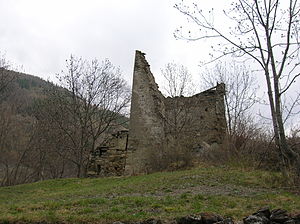Castello di Cré
| Castello di Cré | ||
|---|---|---|
|
The ruins of the Castello di Cré |
||
| Alternative name (s): | Casaforte Ducrest | |
| Creation time : | 10th century | |
| Castle type : | Fixed house | |
| Conservation status: | ruin | |
| Construction: | Quarry stone | |
| Place: | Advices | |
| Geographical location | 45 ° 42 '33.4 " N , 7 ° 8' 45.3" E | |
| Height: | 824 m slm | |
|
|
||
The Castello di Cré , also Casaforte Ducrest , is the ruin of a permanent house on a slope endangered by landslides in the district of Cré next to the creek bed. The permanent house watches over the east side of the Avise settlement , where the younger and better preserved castles Castello di Avise and Castello di Blonay are located.
description
The fortress house no longer has a roof and is overgrown with blackberry bushes ; its ceilings have collapsed and the whole house has fallen into disrepair. Doors and windows still show frames made of worked stone, which, according to André Zanotto, probably date from the 16th century.
history
The permanent house was built around the 10th century, perhaps on behalf of the D'Avises , a noble family from the Aosta Valley, who refused to submit to the House of Savoy in 1191 , at least until 1243, when Ugonetto II and his cousins were subjects by Amadeus IV of Savoy and thanks to this fact the fief Avise was established again. The architect Carlo Nigra , who draws on local historiography, writes:
“The D'Avise family immediately split into many branches that took on the names of the castles they owned: D'Avise , De Blonay , Cré, De Planaval , De Montmayeur , De Rochefort and later D'Arvier . "
In particular, André Zanotto states that the Castello di Cré belonged to Pietro d'Avise , who was vice balivo of Aosta in 1425 .
Little by little, the permanent house took on the name of the Ducrest family (also spelled Ducret ), who took possession of it from the second half of the 15th century, in the person of the Count Bonifacio Ducrest , who came from Le Pont-de-Beauvoisin in Savoy came. The Ducrests died out in the early 18th century.
Gallery images
The loopholes
Individual evidence
- ↑ Advice . Sapere.it. Retrieved July 7, 2020.
- ↑ a b c André Zanotto: Castelli valdostani . Musumeci, Quart (1980) 2002. ISBN 88-7032-049-9 . Pp. 63-64.
- ↑ a b Castello di Cré . Regione Autonoma Valle d'Aosta. September 21, 2011. Retrieved May 20, 2012.
- ^ Jean-Baptiste de Tillier: Historique de la Vallée d'Aoste . L. Mensio. P. 167, 1887. Retrieved July 7, 2020.
- ^ Carlo Nigra: Torri e castelli e case forti del Piemonte dal 1000 al secolo XVI. La Valle d'Aosta . Musumeci, Quart 1974. p. 89.
- ^ Jean-Baptiste de Tillier: Historique de la Vallée d'Aoste . L. Mensio. P. 170, 1887. Retrieved July 7, 2020.
swell
- André Zanotto: Castelli valdostani . Musumeci, Quart (1980) 2002. ISBN 88-7032-049-9 .
- Carlo Nigra: Torri e castelli e case forti del Piemonte dal 1000 al secolo XVI. La Valle d'Aosta . Musumeci, Quart 1974.
- Jean-Baptiste de Tillier: Historique de la Vallée d'Aoste . L. Mensio. 1887. Retrieved July 7, 2020.
- Mauro Minola, Beppe Ronco: Valle d'Aosta. Castelli e fortificazioni . Macchione, Varese 2002. ISBN 88-8340-116-6 . P.56.
Web links
- Castello di Cré . Regione Autonoma Valle d'Aosta. September 21, 2011. Retrieved May 20, 2012.







